|
|
| Übersicht – Contents: | |
Diese Seite ist Teil des Projektes
|
|
| Übersicht – Contents: | |
Flaggen – Flags: |
|
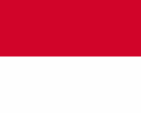 |
National- und Handelsflagge |
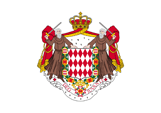 |
Fürstliche und Staatsflagge |
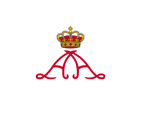 |
Standarte des Fürsten Albert II. |
historische Flaggen – historical Flags: |
|
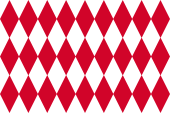 |
17.–19. Jhd./century, |
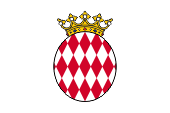 |
1814–1881, |
| Die
Flagge Monacos ist rot-weiß waagerecht gestreift. Offiziell eingeführt wurde
sie durch Karl III. am 04.04.1881. Die Flaggenfarben von Monaco sind die
Farben des Fürstenhauses der Grimaldi, die bereits 1339 urkundlich genannt
sind; sie gehen auf das Wappen der Familie Grimaldi zurück, die das
Fürstentum seit 1297 regiert. In der Praxis wird die Nationalflagge häufig im Format 2:3 verwendet. Dieselben Farben in gleicher Anordnung zeigt rein zufällig die Flagge Indonesiens. |
The flag of Monaco shows two horizontal stripes in red and white. It was officially itroduced by Prince Carl III. on 4th of April in 1881. The colours of the flag of Monaco are the colours of the princely house of the Grimaldi-Familiy which were documentary mentioned already in 1339. They have their roots in the coat of arms of the Grimaldi-Family which rules the principality since the year 1297. In practice the national flag is frequently used in the format 2:3. The same colours in same arrangement shows accidentally the flag of Indonesia. |
| Quelle/Source: Flaggen Wappen Hymnen, Flaggen und Wappen der Welt | |
Wappen – Coat of Arms: |
|
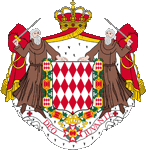 |
Wappen von Monaco – coat of arms of Monaco, Quelle/Source: Corel Draw 4 |
| Das
fürstliche Wappen ist ein silbern-rot-gerauteter Schild, umschlungen von der
Kette des St.-Karl-Ordens. Zwei Mönche (Minoriten) als Schildhalter beziehen
sich auf ein Ereignis in der Geschichte des Fürstenhauses, als ein Grimaldi
mit List eine Festung eroberte. Auf dem Band im unteren Teil des Wappens
steht der Spruch "Deo Iuvante" (mit Gottes Hilfe), der sich auch auf dieses
Ereigniss bezieht. Das Wappen ist in den Grundelementen schon sehr alt und erhielt seine heutige Form um 1800. |
The princely coat of arms shows a shield with silvery and red lozenges surrounded by the necklace of the Order of St. Carl. Two monks (Minorites) are supporters of the shield and refer to a incident in the history of the princely house as a Grimaldi with craftiness conquered a fortification. On a banner in the underneath part of the coat of arms des Wappens the saying "Deo Iuvante" (by God's help) which refers also to this incident. This coat of arms is in its basic elements alreday very old and got its today's form ca. in 1800. |
| Quelle/Source: Flaggen Wappen Hymnen, Flaggen und Wappen der Welt | |
Landkarte – Map: |
Lage – Position: |
Landkarte des Landes – Map of the Country: |
|
|
| Zahlen und Fakten – Numbers and Facts: | |
|
|
|
|
|
|
|
|
|
|
|
|
|
|
|
|
|
|
|
|
|
5. Jh.
v.Chr. · Gründung der Siedlung durch die Phönizier, später Übernahme durch
die Griechen 980 · Monaco wird Kolonie der Stadt Genua 12. Jhd. · Flucht der Familie Grimaldi von Genua nach Monaco 1267 · die Familie Grimaldi übernimmt die Macht 1338 · Monaco wird von Genua unabhängig 1793–1814 · Annexion durch Frankreich (Napoléon) 1815–1860 · Monaco steht unter der Schutzherrschaft des Königreichs Sardinien-Piemont 1731 · die männliche Linie des Hauses Grimaldi stirbt aus 1911 · Einführung einer Verfassung durch Fürst Albert I., Monaco wird konstitutionelle Monarchie 1918 · Schutzvertrag mit Frankreich 1925 · Währungs- und Zollunion mit Frankreich 1962 · neue Verfassung 1949 · Rainier III. wird Fürst von Monaco 1993 · Monaco wird Mitglied der UNO 2005 · Rainier III. stirbt, sein Sohn Albert wird Fürst von Monaco |
|
|
|
|
|
|
|
|
|
5th cent.
B.C. · foundation of the estate by the Phoenicians, afterward takeover by
the Greek 980 · Monaco becomes a colony of the City of Genova 12th cent. · escape of the Grimaldi-Family from Genova to Monaco 1267 · the Grimaldi-Family takes over the power 1338 · Monaco becomes independent from Genova 1793–1814 · annexation by France (Napoléon) 1815–1860 · Monaco is under protectorate of the Kingdom of Sardinia-Piemonte 1731 · the male line of the Grimaldi-House vanishes 1911 · introduction of a constitution by Prince Albert I., Monaco becomes a constitutional monarchy 1918 · protection-treaty with France 1925 · currency and customs union with France 1962 · new constitution 1949 · Rainier III. becomes Prince of Monaco 1993 · Monaco becomes member of the UNO 2005 · Rainier III. dies, his son Albert becomes Prince of Monaco |
| Quelle/Source: Atlas zur Geschichte, World Statesmen, Wikipedia (D) |
|
|
| In der Zeit der Griechen wurde die Siedlung "Monoikos" genannt, was "einzelnes Haus" bedeutet. Die Römer nannten die Siedlung dann "Monoeci Portus", woraus sich im Mittelalter die heutige Bezeichnung "Monaco" entwickelte. | In the
times of the Greek the estate was named "Monoikos", what means "lone house".
The Romans the estate then named "Monoeci Portus", from where developed in
the middle ages the today's name "Monaco". |
| Quelle/Source: Handbuch der geographischen Namen | |